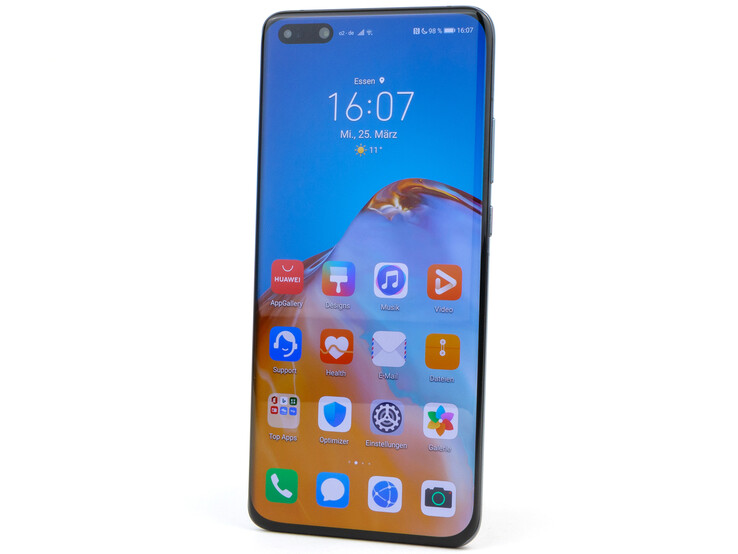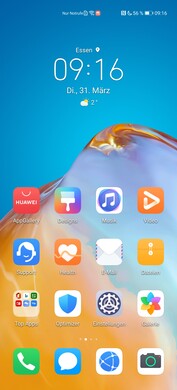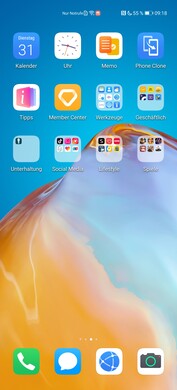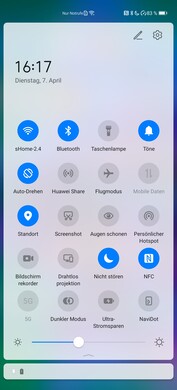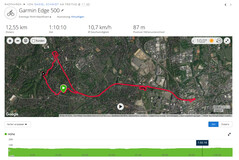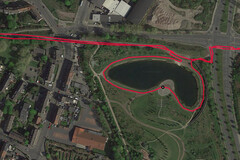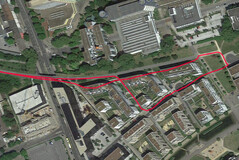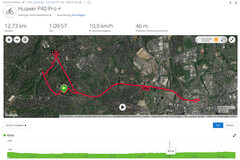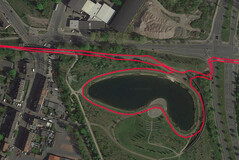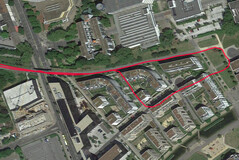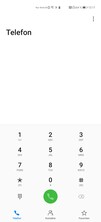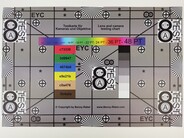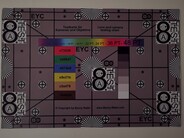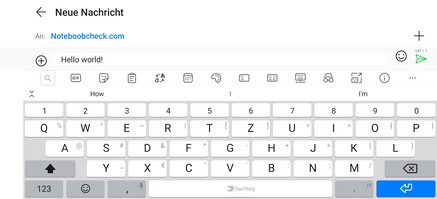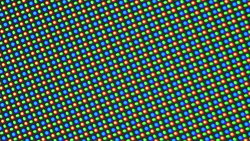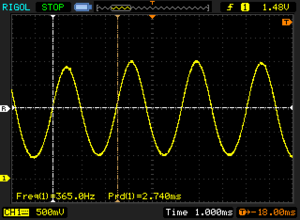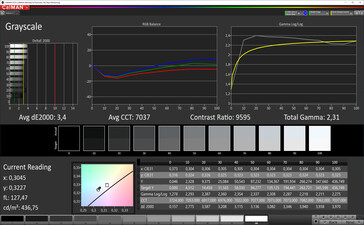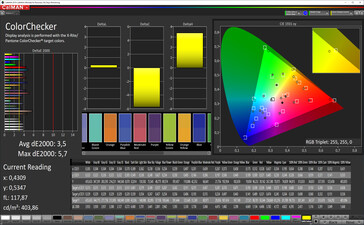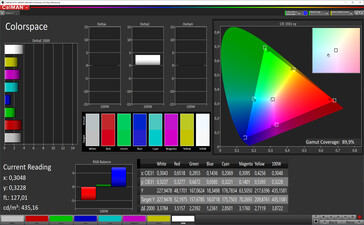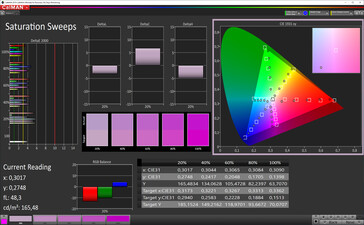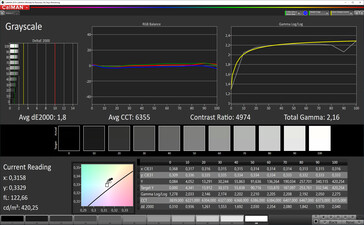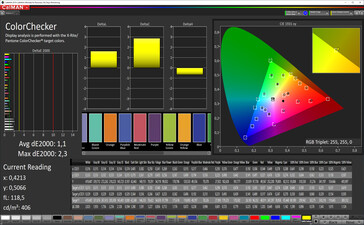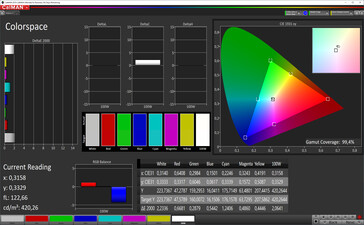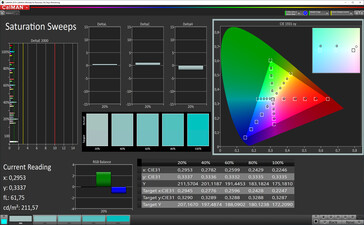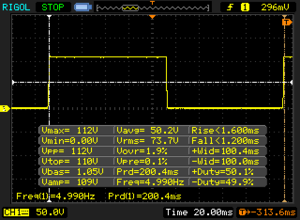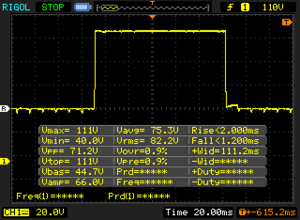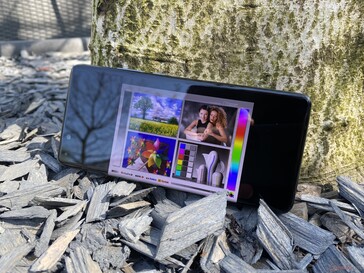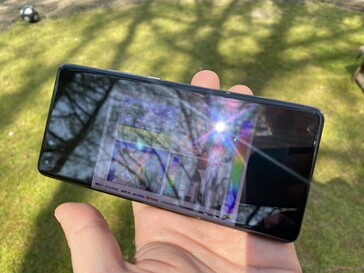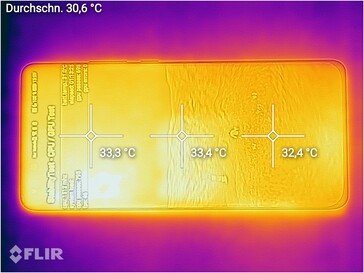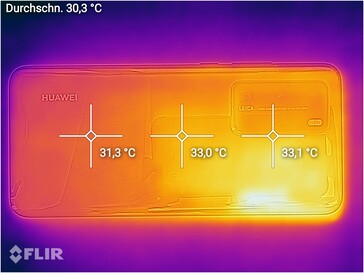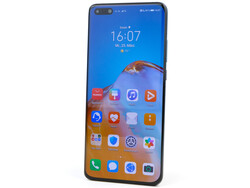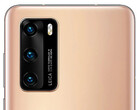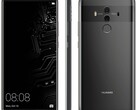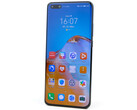Huawei P40 Pro Review - Smartphone with an impressive camera
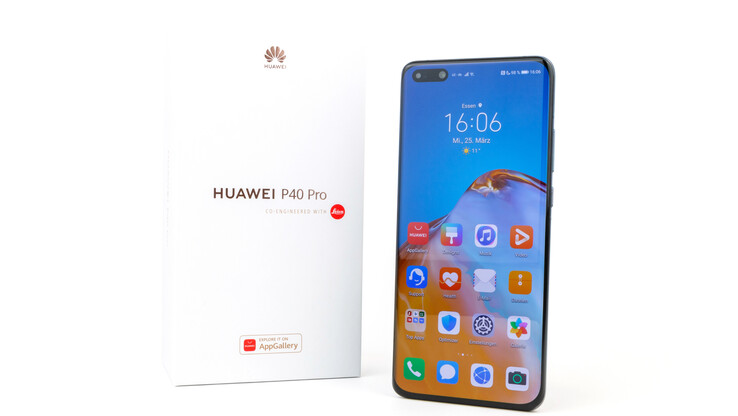
The Huawei P40 Pro is the successor of last year's P30 Pro. While the P40 Lite is already available, the smaller model P40 will be released at the same time as the Pro model. The flagship model P40 Pro Plus, which has an additional zoom lens, more storage and faster charging, is scheduled to be released in the summer.
The P40 Pro is equipped with a 6.58-inch OLED display that supports a refresh rate of 90 Hz. Since it is powered by Huawei's own flagship SoC, 5G is on board by default. There is no 4G-only version and even the storage configuration is fixed. At 999 Euros (~$1,092), the price has dropped compared to the predecessor (1,099 Euros or ~$1,200).
Competing Devices
Rating | Date | Model | Weight | Drive | Size | Resolution | Price |
|---|---|---|---|---|---|---|---|
| 89.4 % v7 (old) | 04 / 2020 | Huawei P40 Pro Kirin 990 5G, Mali-G76 MP16 | 209 g | 256 GB UFS 3.0 Flash | 6.58" | 2640x1200 | |
| 86.1 % v7 (old) | 03 / 2020 | Oppo Find X2 Pro SD 865, Adreno 650 | 202 g | 512 GB UFS 3.0 Flash | 6.70" | 3168x1440 | |
| 88.9 % v7 (old) | 03 / 2020 | Samsung Galaxy S20 Ultra Exynos 990, Mali-G77 MP11 | 219 g | 128 GB UFS 3.0 Flash | 6.90" | 3200x1440 | |
| 87.8 % v7 (old) | 09 / 2019 | Apple iPhone 11 Pro A13 Bionic, A13 Bionic GPU | 188 g | 256 GB NVMe | 5.80" | 2436x1125 | |
| 83.8 % v7 (old) | 01 / 2020 | Xiaomi Mi Note 10 Pro SD 730G, Adreno 618 | 208 g | 256 GB UFS 2.0 Flash | 6.47" | 2340x1080 |
Case - Fewer Colors for the P40 Pro
In terms of the color selection, Huawei has taken a much more conservative approach and made only three color options available for the P40 Pro: Black, Blush Gold and Silver Frost. The exterior once again consists of glass with a metal frame. This time, not just the left and right sides of the glass but all four sides are rounded-off, which looks nice and does not impair daily use, since the curvature is not too pronounced.
The build quality is solid overall. While the clearances are tight, they could be more even in some instances. For example, the distance between the glass back and the frame is larger in the middle and decreases towards the corners. The smartphone is not susceptible to twisting, and it withstands reasonable amounts of pressure.
The Huawei P40 Pro is protected against dust and water according to IP68. The SIM tray cover has an almost identical color as the frame and accepts either two nano-SIM or a nano-memory card instead of the second SIM card.
Features - Huawei Continues to Rely on an NM Card
Huawei continues to rely on its own nano-memory card form factor with identical dimensions as nano-SIM cards and capacities of up to 256 GB. As such, availability is not a problem, although the cards are more expensive compared to the much more common microSD cards. However, the file system exFAT is supported, which allows users to store individual files with a size that exceeds 4 GB on the memory card. While the storage cannot be reformatted as internal storage, transferring app data to it is supported.
The USB port can transfer data according to the 3.1 specification (Gen. 1) and offers wired video output via an optional adapter to HDMI or DisplayPort interfaces. Furthermore, the desktop mode is once again available. Similarly, the IR transmitter that can be used to remote control electronic devices and DSLRs is on board again as well.
Due to the trade conflict, there are a few limitations when it comes to Bluetooth 5.1, such as the lack of support for the audio codecs aptX and aptX HD - instead, only SBC, AAC, LDAC and LHDC are supported. There is also no notification LED. For visual notification alerts, users will have to rely on the always-on display.
Software - Huawei's AppGallery Is Not a Perfect Substitute
The Huawei P40 Pro runs Android 10 with the EMUI 10.1 overlay. Features of the newer version of Huawei's UI include the integration of MeeTime and the ability to share the smartphone's microphone and cameras with a Huawei laptop.
Apps can be installed from the Huawei AppGallery, whereas Google services or the Play Store are not preinstalled. Manually installing these apps is not a simple task, either, and it can only be accomplished with root permissions. While many common apps are already available on the AppGallery, popular messenger and social media apps in particular tend to be missing, since they often stem from US companies. Those who already own a Huawei phone can copy over their data during the initial setup with the app Phone Clone, which even preserves WhatsApp chat logs. WhatsApp can be downloaded directly from the company's web page in order to install the app on the smartphone, but this method does not allow for automatic updates. Other messengers such as Signal or Threema are still missing as well. At least the Facebook apps can be installed fairly easily after downloading the Amazon App Store.
Due to the lack of a Google certification, DRM-protected content cannot be viewed at HD resolutions.
Communication and GNSS - Huawei P40 Pro with Powerful Wi-Fi and 5G
The Huawei P40 Pro can connect to the internet via all modern mobile communications standards. Since a wide range of both LTE and 5G frequencies is supported, worldwide network connectivity should not be a problem. The 5G modem of the Chinese manufacturer is part of the SoC and supposedly significantly more power efficient than the dedicated modems of competitors, and even though it only supports sub-6 5G, very fast transfer rates are possible regardless. In theory, the P40 Pro is capable of download speeds of up to 2.3 Gb/s and upload speeds of up to 1.25 Gb/s.
A Wi-Fi 6 module with MIMO antenna technology and support for the 160-MHz band is available for Wi-Fi connections, allowing for transfer rates of up to 2.4 Gb/s. Thus, Huawei delivers a Wi-Fi performance that is twice as fast as those of its competitors, which are exclusively VHT80-based (up to 1.2 Gb/s). While it is no surprise that the theoretical peak was not reached in our test, the P40 Pro achieves maximum transmission speeds of up to 1.6 Gb/s when paired with our reference router Netgear Nighthawk AX12 and while the reception speeds are fairly quick as well, they are not quite as high since the performance is limited when receiving data.
For geolocation, the Huawei P40 Pro uses the satellite systems GPS, GLONASS, BeiDou and Galileo, while also supporting dual-band GNSS. The satellite uplink is established very quickly and accurately outdoors, whereas it requires more patience indoors and the precision is lower as well.
On our short bike ride, the smartphone has to go up against the Garmin Edge 500. For a route with a total length of 12 kilometers, the difference between the two devices amounts to 180 meters. Here, the P40 more accurately tracks our position during the turn, while the locating capabilities of the bike computer are more precise while circling the lake. The Huawei smartphone makes no dramatic errors and is thus well-suited for all navigation tasks.
Telephony and Call Quality
The telephony app of the Huawei P40 Pro is similar to the Google version, very well structured and focused on the essentials. Modern features such as VoLTE and Wi-Fi calling are supported and an eSIM can be used in place of a second SIM card. Although 5G is generally supported for both SIMs, only one SIM can be 5G-enabled at a time.
We were pleased with the call quality. When held against an ear, the person on the other end of the line sounds fairly natural and slightly dull. Ambient noise cancelling reliably filters out background noise and makes sure that the user's voice sounds clear and distinct, even when whispering in loud environments.
The speakerphone is solid overall as well and although it makes the user sound somewhat bright, it is very sensitive and moving a small distance away from the smartphone incurs no loss in quality.
Cameras - Huawei Opts for Quality over Quantity
The front camera features many megapixels and also, finally, an autofocus. The pixel-binning technology enhances pictures taken in poor lighting conditions. Videos can be recorded at Ultra HD and up to 60 frames per second. Compared to competitors, we like the recordings for their natural color reproduction. However, details could be captured with a higher accuracy, since they look fairly rough at the maximum zoom level. That being said, the optics are very well-suited to social media fans, and they offer countless options for optimizing the image.
The centerpiece of the camera on the back is the brand-new sensor of the main optics, and while at 1/1.28 inches it is larger than Samsung's counterpart, its resolution of 50 MP results in a smaller pixel count for significantly bigger pixels (1.22 µm) that promise a higher light sensitivity. The pixel size increases to 2.4 µm after accounting for pixel binning. Practical tests confirm the strong performance, which the specifications hint at and the Huawei P40 Pro is particularly far ahead of its competition in low-light scenes. The night mode has been further improved as well and achieves good results. While the color balance is slightly cooler compared to competitors, the P40 Pro captures the most detailed picture. The comparison also illustrates that competitors have come a long way when it comes to catching up in this aspect.
Huawei once again relies on an optical 5x magnification via periscope lens, which also supports 10x hybrid as well as up to 50x digital zoom. Thanks to the optical image stabilizers for all optics and an improved AIS, objects remain fairly well stabilized even at maximum zoom, although at least a fixed background is desirable. The image quality is relatively good and the edge that the P40 Pro has over its competition primarily shows at higher zoom levels.
Pictures taken at 10x zoom (from the left): Huawei P40 Pro, iPhone 11 Pro, Galaxy S20 Ultra and Xiaomi Mi 10 Pro
Pictures taken at 50x zoom (from the left): Huawei P40 Pro, Galaxy S20 Ultra und Xiaomi Mi 10 Pro
For the ultra wide-angle lens, Huawei uses the ultra-wide cine lens from the Mate 30 Pro, which is also primarily responsible for video recording. The 40 MP sensor is powerful when compared to competing solutions and makes Huawei's video-capturing performance the new reference, particularly in low-light scenarios. Videos can also be recorded at Ultra HD with up to 60 FPS and still benefit from a decent stabilization. During the recording, the zoom is infinitely variable up to a 10x magnification. Although sound is captured very clearly and with a low amount of static, only mono audio is supported.
Unfortunately, the Golden Snap feature of the Huawei P40 Pro only reached us towards the end of our review via an update, leaving us unable to sufficiently test it. This feature can remove unintentionally captured people in the background or distracting reflections. We will append the results to our review at a later date.
Under controlled lighting conditions, the P40 Pro confirms its subjectively good real-world performance and delivers a good image in terms of the sharpness that degrades rather quickly towards the edges. Color gradients and text are no challenge for the smartphone and both are displayed very clearly.
As with the Mate 30 Pro, colors appear more natural in the dark. Although there are no severe outliers in daylight, either, the image brightening goes overboard with a few colors.

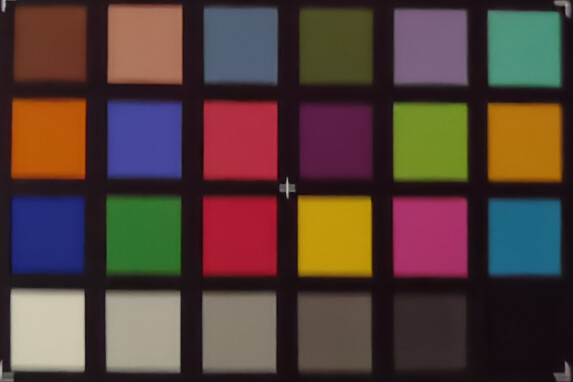
Accessories and Warranty
Huawei offers a 24-month warranty for its smartphone that can neither be extended nor expanded. The package content includes a modular charger (40-watt), a USB 2.0 cable (Type-A to Type-C), a wired headset, a SIM tool, a transparent silicone bumper, security information and a quick-start guide.
Huawei has optional wireless-charging covers, memory cards and various protective cases on offer.
Input Devices & Handling
The capacitive touchscreen of the Huawei P40 Pro supports up to 10 multi-touch points simultaneously and offers great gliding properties as well as an accurate input recognition. The vibration motor that complements it is powerful and not too loud, although it does not match the quality of its Pixel 4 and iPhone counterparts. Additionally, users will have to manually enable it via the settings menu.
As with the Mate 30 Pro, the P40 Pro also recognizes gestures with the help of the second front camera, which houses an IR projector. While it supports facial recognition as well, it is still only two-dimensional. Although it worked well in our test, there is usually a one-second delay in dark environments. The fingerprint sensor below the display is easily accessible and quickly and reliably unlocks the smartphone.
Display - Huawei Phone with a Color-accurate 90-Hz OLED Display
The OLED panel spans 6.58 inches diagonally (16.71 cm, 105.2 cm²), has a refresh rate of 90 Hz and it offers a sharp picture despite its Full HD+ resolution. Compared to competitors, the brightness is relatively low and smartphones equipped with Samsung's latest AMOLED displays tend to offer more headroom in terms of the brightness.
With the ambient light sensor disabled, the panel reaches a maximum of 437 cd/m² and even with evenly distributed bright and dark areas (APL50) we measured a brightness of only 572 cd/m² coming from the OLED screen, which means that even non-DRM content cannot be displayed in HDR.
The use of pulse-width modulation to control the brightness is common on OLED panels and in this case present with a frequency ranging from 352.1 Hz to 365 Hz. This can cause issues for sensitive users. For these cases, there is a flicker reduction option (DC dimming) under the menu item eye comfort.
| |||||||||||||||||||||||||
Brightness Distribution: 95 %
Center on Battery: 584 cd/m²
Contrast: ∞:1 (Black: 0 cd/m²)
ΔE ColorChecker Calman: 1.1 | ∀{0.5-29.43 Ø4.78}
ΔE Greyscale Calman: 1.8 | ∀{0.09-98 Ø5}
99.4% sRGB (Calman 2D)
Gamma: 2.16
CCT: 6355 K
| Huawei P40 Pro OLED, 2640x1200, 6.6" | Huawei P30 Pro OLED, 2340x1080, 6.5" | Samsung Galaxy S20 Ultra Dynamic AMOLED 2X, 3200x1440, 6.9" | Apple iPhone 11 Pro OLED, 2436x1125, 5.8" | Xiaomi Mi Note 10 Pro AMOLED, 2340x1080, 6.5" | Oppo Find X2 Pro AMOLED, 3168x1440, 6.7" | |
|---|---|---|---|---|---|---|
| Screen | -24% | -64% | 12% | -116% | -120% | |
| Brightness middle (cd/m²) | 584 | 597 2% | 734 26% | 787 35% | 579 -1% | 778 33% |
| Brightness (cd/m²) | 576 | 608 6% | 748 30% | 793 38% | 576 0% | 775 35% |
| Brightness Distribution (%) | 95 | 89 -6% | 95 0% | 98 3% | 89 -6% | 99 4% |
| Black Level * (cd/m²) | ||||||
| Colorchecker dE 2000 * | 1.1 | 2.2 -100% | 3.2 -191% | 1.2 -9% | 4.61 -319% | 4.4 -300% |
| Colorchecker dE 2000 max. * | 2.3 | 3.6 -57% | 6.8 -196% | 2.6 -13% | 7.72 -236% | 8.7 -278% |
| Greyscale dE 2000 * | 1.8 | 1.6 11% | 2.7 -50% | 1.5 17% | 4.2 -133% | 5.6 -211% |
| Gamma | 2.16 102% | 2.23 99% | 2.11 104% | 2.2 100% | 2.244 98% | 2.26 97% |
| CCT | 6355 102% | 6268 104% | 6299 103% | 6339 103% | 7201 90% | 7250 90% |
* ... smaller is better
Screen Flickering / PWM (Pulse-Width Modulation)
| Screen flickering / PWM detected | 365 Hz | ≤ 99 % brightness setting | |
The display backlight flickers at 365 Hz (worst case, e.g., utilizing PWM) Flickering detected at a brightness setting of 99 % and below. There should be no flickering or PWM above this brightness setting. The frequency of 365 Hz is relatively high, so most users sensitive to PWM should not notice any flickering. However, there are reports that some users are still sensitive to PWM at 500 Hz and above, so be aware. In comparison: 53 % of all tested devices do not use PWM to dim the display. If PWM was detected, an average of 8118 (minimum: 5 - maximum: 343500) Hz was measured. | |||
We further analyzed the color accuracy using the software CalMAN. The Huawei P40 Pro shows a very good color representation with no severe outliers. The smartphone is very close to the ideal when the color profile Normal is selected, which uses the smaller sRGB color space.
Display Response Times
| ↔ Response Time Black to White | ||
|---|---|---|
| 2.8 ms ... rise ↗ and fall ↘ combined | ↗ 1.6 ms rise | |
| ↘ 1.2 ms fall | ||
| The screen shows very fast response rates in our tests and should be very well suited for fast-paced gaming. In comparison, all tested devices range from 0.1 (minimum) to 240 (maximum) ms. » 12 % of all devices are better. This means that the measured response time is better than the average of all tested devices (20.2 ms). | ||
| ↔ Response Time 50% Grey to 80% Grey | ||
| 3.2 ms ... rise ↗ and fall ↘ combined | ↗ 2 ms rise | |
| ↘ 1.2 ms fall | ||
| The screen shows very fast response rates in our tests and should be very well suited for fast-paced gaming. In comparison, all tested devices range from 0.165 (minimum) to 636 (maximum) ms. » 12 % of all devices are better. This means that the measured response time is better than the average of all tested devices (31.6 ms). | ||
Performance - Powerful Kirin 990 5G
The Kirin 990 5G inside the P40 Pro not only has an onboard 5G modem but also a slightly higher clock speed than the regular Kirin 990. On top of it, users get 8 GB of LPDDR4x RAM and an integrated ARM Mali-G76 MP16 for graphics calculations.
Although the SoC is between 2% and 9% faster than its non-5G counterpart, there should be no noticeable difference during daily use. The Kirin 990 is one of the fastest SoCs on the market currently, even though it cannot quite match the latest chips from Apple and Qualcomm.
| AnTuTu v8 - Total Score (sort by value) | |
| Huawei P40 Pro | |
| Oppo Find X2 Pro | |
| Samsung Galaxy S20 Ultra | |
| Apple iPhone 11 Pro | |
| Huawei P30 Pro | |
| Huawei Mate 30 Pro | |
| Average HiSilicon Kirin 990 5G (450373 - 527856, n=4) | |
| VRMark - Amber Room (sort by value) | |
| Huawei P40 Pro | |
| Oppo Find X2 Pro | |
| Samsung Galaxy S20 Ultra | |
| Huawei P30 Pro | |
| Huawei Mate 30 Pro | |
| Average HiSilicon Kirin 990 5G (4980 - 5037, n=2) | |
The P40 Pro comes with the Huawei Browser 10.1, which provides push news functionality and uses Bing as its default search engine, preinstalled. The P40 Pro's web-browsing performance is good and second only to the iPhone according to our benchmarks.
| Jetstream 2 - 2.0 Total Score | |
| Average of class Smartphone (23.8 - 387, n=153, last 2 years) | |
| Apple iPhone 11 Pro (Safari Mobile 13.0) | |
| Huawei P40 Pro (Huawei Browser 10.1) | |
| Oppo Find X2 Pro (Chrome 80) | |
| Average HiSilicon Kirin 990 5G (55.6 - 70, n=4) | |
| Huawei P30 Pro (Chrome 73) | |
| Samsung Galaxy S20 Ultra (Chrome 80) | |
| JetStream 1.1 - Total Score | |
| Apple iPhone 11 Pro (Safari Mobile 13.0) | |
| Huawei P40 Pro (Huawei Browser 10.1) | |
| Oppo Find X2 Pro (Chrome 80) | |
| Average HiSilicon Kirin 990 5G (103.2 - 116.6, n=4) | |
| Samsung Galaxy S20 Ultra (Chrome 80) | |
| Speedometer 2.0 - Result 2.0 | |
| Average of class Smartphone (15.2 - 643, n=128, last 2 years) | |
| Apple iPhone 11 Pro (Safari Mobile 13.0) | |
| Huawei P40 Pro (Huawei Browser 10.1) | |
| Oppo Find X2 Pro (Chrome 80) | |
| Huawei P30 Pro (Chrome 73) | |
| Average HiSilicon Kirin 990 5G (63 - 71.8, n=4) | |
| Samsung Galaxy S20 Ultra (Chrome 80) | |
| WebXPRT 3 - Overall | |
| Apple iPhone 11 Pro (Safari Mobile 13.0) | |
| Average of class Smartphone (38 - 380, n=35, last 2 years) | |
| Huawei P30 Pro (Chrome 73) | |
| Average HiSilicon Kirin 990 5G (95 - 124, n=3) | |
| Oppo Find X2 Pro (Chrome 80) | |
| Samsung Galaxy S20 Ultra (Chrome 80) | |
| Huawei P40 Pro | |
| Octane V2 - Total Score | |
| Apple iPhone 11 Pro (Safari Mobile 13.0) | |
| Average of class Smartphone (2228 - 121337, n=200, last 2 years) | |
| Huawei P40 Pro (Huawei Browser 10.1) | |
| Oppo Find X2 Pro (Chrome 80) | |
| Huawei P30 Pro (Chrome 73) | |
| Average HiSilicon Kirin 990 5G (20917 - 23690, n=4) | |
| Samsung Galaxy S20 Ultra (Chrome 80) | |
| Mozilla Kraken 1.1 - Total | |
| Samsung Galaxy S20 Ultra (Chrome 80) | |
| Average HiSilicon Kirin 990 5G (1914 - 2287, n=4) | |
| Oppo Find X2 Pro (Chrome 80) | |
| Huawei P30 Pro (Chrome 73) | |
| Huawei P40 Pro (Huawei Browser 10.1) | |
| Average of class Smartphone (257 - 28190, n=155, last 2 years) | |
| Apple iPhone 11 Pro (Safari Mobile 13.0) | |
* ... smaller is better
The Huawei P40 Pro has access to 256 GB of UFS 3.0 storage for blazing-fast transfer speeds. However, the write performance falls short of our expectations by a quite significant margin.
The card slot almost fully exhausts the capabilities of the NM card.
| Huawei P40 Pro | Oppo Find X2 Pro | Samsung Galaxy S20 Ultra | Xiaomi Mi Note 10 Pro | Huawei P30 Pro | Average 256 GB UFS 3.0 Flash | Average of class Smartphone | |
|---|---|---|---|---|---|---|---|
| AndroBench 3-5 | 10% | 1% | -57% | -26% | -6% | 110% | |
| Sequential Read 256KB (MB/s) | 1775 | 1606 -10% | 1632 -8% | 499.2 -72% | 849 -52% | 1547 ? -13% | 2223 ? 25% |
| Sequential Write 256KB (MB/s) | 395.7 | 729 84% | 697 76% | 205.1 -48% | 250.8 -37% | 575 ? 45% | 1838 ? 364% |
| Random Read 4KB (MB/s) | 228.1 | 202.6 -11% | 202.4 -11% | 119.2 -48% | 174.4 -24% | 210 ? -8% | 295 ? 29% |
| Random Write 4KB (MB/s) | 271.8 | 205 -25% | 221.4 -19% | 108.5 -60% | 159.2 -41% | 188.5 ? -31% | 335 ? 23% |
| Sequential Read 256KB SDCard (MB/s) | 82.3 ? | 67.6 ? -18% | 82.6 ? 0% | 70.6 ? -14% | |||
| Sequential Write 256KB SDCard (MB/s) | 68.1 ? | 58.3 ? -14% | 68.2 ? 0% | 59.8 ? -12% |
Gaming - Fun and Games
The ARM Mali-G76 MP16 inside the Huawei P40 Pro delivers a strong graphics performance, and it is able to smoothly run all Android games. However, the 90-Hz refresh rate is unfortunately not noticeable while gaming, since it is often simply not supported. Furthermore, Asphalt 9 did not run correctly and immediately crashed after the app was launched.
We used GameBench to monitor the performance of the Huawei smartphone and the P40 Pro delivered stable frame rates and registered inputs reliably. The only drawback we encountered was that it is easy to block the speaker in landscape mode.
Emissions - P40 Pro with a Weak Dual-Speaker Setup
Temperature
The surface temperatures of the Huawei P40 Pro are cool and barely increase even under load, matching our expectations.
We used GFXBench's battery test to monitor the behavior of the SoC during a prolonged load by running the same test in a loop 30 times in succession and logging the battery charge and the frame rates. The Huawei phone delivers a stable performance in the older T-Rex benchmark, and even in the Manhattan test the frame rates remain consistent for a long time before dropping off by around 23% during the last loop.
(+) The maximum temperature on the upper side is 30.2 °C / 86 F, compared to the average of 35.2 °C / 95 F, ranging from 21.9 to 247 °C for the class Smartphone.
(+) The bottom heats up to a maximum of 30.6 °C / 87 F, compared to the average of 34 °C / 93 F
(+) In idle usage, the average temperature for the upper side is 27.8 °C / 82 F, compared to the device average of 32.9 °C / 91 F.
Speakers
There is one speaker on the bottom edge and one below the display of the Huawei P40 Pro. The latter packs less of a punch, which makes their combined sound appear weak and hollow, since the upper mid and higher tones are overrepresented. As a result, it is hard to get excited about the overall audio experience.
Wired USB Type-C or wireless Bluetooth solutions represent a better alternative. That being said, users should not expect anything out of the ordinary from the included headset.
Huawei P40 Pro audio analysis
(+) | speakers can play relatively loud (89.1 dB)
Bass 100 - 315 Hz
(-) | nearly no bass - on average 27.3% lower than median
(±) | linearity of bass is average (11.8% delta to prev. frequency)
Mids 400 - 2000 Hz
(±) | reduced mids - on average 5.3% lower than median
(+) | mids are linear (4.8% delta to prev. frequency)
Highs 2 - 16 kHz
(+) | balanced highs - only 4.4% away from median
(+) | highs are linear (2.7% delta to prev. frequency)
Overall 100 - 16.000 Hz
(±) | linearity of overall sound is average (18.5% difference to median)
Compared to same class
» 20% of all tested devices in this class were better, 9% similar, 71% worse
» The best had a delta of 11%, average was 35%, worst was 134%
Compared to all devices tested
» 40% of all tested devices were better, 8% similar, 52% worse
» The best had a delta of 4%, average was 24%, worst was 134%
Apple iPhone 11 Pro audio analysis
(+) | speakers can play relatively loud (85 dB)
Bass 100 - 315 Hz
(-) | nearly no bass - on average 15.9% lower than median
(±) | linearity of bass is average (11% delta to prev. frequency)
Mids 400 - 2000 Hz
(+) | balanced mids - only 4.8% away from median
(±) | linearity of mids is average (7% delta to prev. frequency)
Highs 2 - 16 kHz
(±) | higher highs - on average 9.3% higher than median
(+) | highs are linear (2.9% delta to prev. frequency)
Overall 100 - 16.000 Hz
(±) | linearity of overall sound is average (19.1% difference to median)
Compared to same class
» 24% of all tested devices in this class were better, 9% similar, 67% worse
» The best had a delta of 11%, average was 35%, worst was 134%
Compared to all devices tested
» 45% of all tested devices were better, 7% similar, 48% worse
» The best had a delta of 4%, average was 24%, worst was 134%
Battery Life
Energy Consumption
We measured the power consumption with the 90-Hz mode enabled. Disabling it reduces the energy consumption by 0.11 watts while idling. However, the idle consumption is fairly low even with the higher refresh rate. Meanwhile, the only energy consumption value that sticks out is the consumption at minimum brightness, which is slightly higher than expected.
The P40 Pro can be charged with a cable at up to 40 watts, which means fully charging the device takes 84 minutes. Via wireless, a charge rate of up to 27 watts is possible and other devices can once again be charged wirelessly as well.
| Off / Standby | |
| Idle | |
| Load |
|
Key:
min: | |
| Huawei P40 Pro 4200 mAh | Oppo Find X2 Pro 4260 mAh | Samsung Galaxy S20 Ultra 5000 mAh | Apple iPhone 11 Pro 3046 mAh | Huawei P30 Pro 4200 mAh | Average HiSilicon Kirin 990 5G | Average of class Smartphone | |
|---|---|---|---|---|---|---|---|
| Power Consumption | -99% | -30% | -4% | -33% | -37% | -38% | |
| Idle Minimum * (Watt) | 0.92 | 1.47 -60% | 0.76 17% | 0.58 37% | 0.68 26% | 1.24 ? -35% | 0.848 ? 8% |
| Idle Average * (Watt) | 1.41 | 3.43 -143% | 1.91 -35% | 1.99 -41% | 2.6 -84% | 2.33 ? -65% | 1.435 ? -2% |
| Idle Maximum * (Watt) | 1.47 | 3.52 -139% | 1.96 -33% | 2.03 -38% | 2.77 -88% | 2.49 ? -69% | 1.621 ? -10% |
| Load Average * (Watt) | 3.35 | 6.2 -85% | 4.72 -41% | 3.13 7% | 3.74 -12% | 3.55 ? -6% | 6.99 ? -109% |
| Load Maximum * (Watt) | 6.37 | 10.63 -67% | 10.15 -59% | 5.43 15% | 6.82 -7% | 7.09 ? -11% | 11.3 ? -77% |
* ... smaller is better
Battery Life
Even though the P40 Pro's battery life is worse in all scenarios compared to its predecessor, it is still good overall. Particularly the Wi-Fi tests left something to be desired. That being said, it is very possible for the new Wi-Fi 6+ to be poorly optimized, which would mean that there is room for improvement in terms of the runtimes.
| Huawei P40 Pro 4200 mAh | Oppo Find X2 Pro 4260 mAh | Samsung Galaxy S20 Ultra 5000 mAh | Apple iPhone 11 Pro 3046 mAh | Xiaomi Mi Note 10 Pro 5260 mAh | Huawei P30 Pro 4200 mAh | |
|---|---|---|---|---|---|---|
| Battery runtime | -12% | 9% | 27% | 49% | 31% | |
| Reader / Idle (h) | 24.6 | 31 26% | 34.7 41% | 32.8 33% | ||
| H.264 (h) | 19 | 18.9 -1% | 17.4 -8% | 19.9 5% | ||
| WiFi v1.3 (h) | 12.4 | 10.9 -12% | 12 -3% | 13.2 6% | 18.5 49% | 14 13% |
| Load (h) | 3.3 | 3.7 12% | 5.6 70% | 5.7 73% |
Pros
Cons
Verdict - Wouldn't It Be Nice…
With the P40 Pro, Huawei has once again released an excellent camera smartphone and most likely even the best camera phone available right now. However, the drawbacks do not stem from the hardware but rather the software. Although there are certain workarounds for the missing Google services and the resulting lack of the Play Store, many apps and comfort features are still missing. Additionally, the smartphone DRM certification is under Google's authority and thus it is not possible to stream the encrypted HD content. Similarly, popular Bluetooth audio codecs such as aptX and aptX HD are missing.
While the Huawei P40 Pro features powerful hardware and a great camera, the AppGallery currently cannot make up for the lack of Google services.
The P40 Pro's hardware package consists of high-end features such as a fast SoC, 5G, the fastest Wi-Fi currently available on a smartphone and a 90-Hz display. That being said, the latter could offer slightly more headroom in terms of the brightness.
Although the Huawei P40 Pro is definitely a contender for being one of the best smartphones on the market, the lack of many apps as well as Google integration means that less-advanced users in particular may struggle when trying to access popular apps.
Huawei P40 Pro
- 08/31/2022 v7 (old)
Daniel Schmidt




